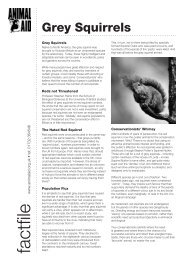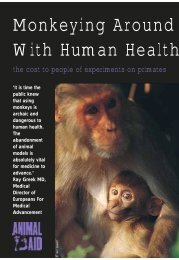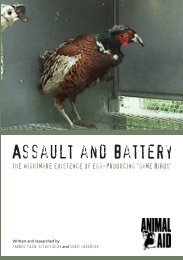Read Animal Aid's scientific Briefing on the Bristol experiments
Read Animal Aid's scientific Briefing on the Bristol experiments
Read Animal Aid's scientific Briefing on the Bristol experiments
Create successful ePaper yourself
Turn your PDF publications into a flip-book with our unique Google optimized e-Paper software.
about pain, but this knowledge has failed to yield new<br />
painkillers for humans’. A 2010 meta-analysis of 174<br />
randomised c<strong>on</strong>trolled trials (RCTs) of neuropathic pain<br />
treatments found that <strong>the</strong> majority of patients saw no<br />
benefit, with a high number of early drop-outs because<br />
of adverse drug reacti<strong>on</strong>s. A L<strong>on</strong>d<strong>on</strong> researcher<br />
commented at that time: ‘The animal models of<br />
neuropathic pain just d<strong>on</strong>’t seem to be that efficient.’<br />
poor mimic of human disease. The damage induced in<br />
young, genetically identical and usually male animals is<br />
fundamentally different from <strong>the</strong> pain experienced by<br />
patients with chr<strong>on</strong>ic diseases, who are often elderly.<br />
The kind of neuropathic pain experienced by patients<br />
with diabetes, post-viral syndromes and cancer, for<br />
example, is not due to injury of <strong>the</strong>ir peripheral nerves<br />
such as that inflicted <strong>on</strong> <strong>the</strong> <strong>Bristol</strong> mice.<br />
The <strong>Bristol</strong> <strong>experiments</strong> are no excepti<strong>on</strong>. Despite<br />
inflicting c<strong>on</strong>siderable suffering <strong>on</strong> animals, <strong>the</strong>y have<br />
so far produced no c<strong>on</strong>crete benefits for patients.<br />
Galanin was discovered in 1978. It bel<strong>on</strong>gs to a group<br />
of substances known as neuropeptides, because of<br />
<strong>the</strong>ir role in biological communicati<strong>on</strong>s between nerve<br />
cells. Galanin is found widely in mammalian central<br />
and peripheral nervous systems, and also in horm<strong>on</strong>e<br />
producing organs. The chemical is involved in several<br />
biological processes, including pain percepti<strong>on</strong>, eating<br />
and sleep regulati<strong>on</strong> and mood. However, despite<br />
decades of basic research (mainly but not exclusively<br />
using rodents), <strong>the</strong> roles of galanin in <strong>the</strong> human<br />
body remain far from clear. Molecules that both block<br />
and stimulate galanin receptors have been tested in<br />
‘animal models’ of pain, epilepsy, Alzheimer’s disease,<br />
morphine addicti<strong>on</strong>, alcoholism, eating disorders,<br />
depressi<strong>on</strong> and anxiety. Many of <strong>the</strong>se <strong>experiments</strong><br />
involve manifestly cruel physical and psychological<br />
torments.<br />
The disc<strong>on</strong>nect between <strong>the</strong> preclinical animal studies<br />
and <strong>the</strong> subsequent human trials is enormous. A 2008<br />
article, authored by animal pain researchers, points out<br />
that ‘of <strong>the</strong> 123 interventi<strong>on</strong>s assessed in <strong>the</strong> 105 RCTs<br />
included in a recent clinical meta-analysis, 53% were<br />
c<strong>on</strong>ducted in patients with peripheral polyneuropathies<br />
and 21% were in post-herpetic neuralgia patients. In<br />
c<strong>on</strong>trast, <strong>on</strong>ly 9% of <strong>the</strong> RCTs studied patients with<br />
peripheral nerve injury.’<br />
Ano<strong>the</strong>r reas<strong>on</strong> for <strong>the</strong> systematic failure to help<br />
human patients is <strong>the</strong> measurement of largely irrelevant<br />
data. These <strong>experiments</strong> are measuring evoked<br />
hypersensitivity of a mouse paw after a peripheral nerve<br />
injury, via withdrawal from a painful stimulus. However,<br />
<strong>the</strong> predominant symptom suffered by patients with<br />
neuropathic pain (and <strong>the</strong>refore <strong>the</strong> primary measure<br />
of a treatment’s efficacy) is sp<strong>on</strong>taneous pain.<br />
Limb withdrawal in an injured animal is expected<br />
to somehow represent patients’ pain intensity and<br />
character, psychological status, sleep disturbance,<br />
physical functi<strong>on</strong> and overall quality of life.<br />
‘A measurable failure of replacement<br />
and reducti<strong>on</strong>’<br />
<str<strong>on</strong>g>Briefing</str<strong>on</strong>g> sheet<br />
www.animalaid.org.uk • tel: 01732 364546<br />
Mouse in nerve damage experiment<br />
However, this c<strong>on</strong>tinued inflicti<strong>on</strong> of suffering has not<br />
resulted, to date, in even <strong>on</strong>e galanin-based drug<br />
being approved for use in any human disease. In<br />
fact, <strong>the</strong> <str<strong>on</strong>g>scientific</str<strong>on</strong>g> literature is littered with speculative<br />
declarati<strong>on</strong>s of <strong>the</strong>rapeutic breakthroughs that date<br />
back at least 25 years. The Home Office summary of<br />
<strong>the</strong> <strong>Bristol</strong> <strong>experiments</strong> makes clear that <strong>the</strong> primary<br />
purpose of <strong>the</strong> <strong>experiments</strong> is not patient care, but <strong>the</strong><br />
acquisti<strong>on</strong> of ‘new knowledge’, and that ‘<strong>the</strong> aim is<br />
to publish <strong>the</strong> findings in academic journals’. Human<br />
health is <strong>on</strong>ly a ‘sec<strong>on</strong>dary potential benefit…in so far<br />
as <strong>the</strong> results may at some later stage be of value in<br />
<strong>the</strong> development of new pharmaceutical products’.<br />
Pain research <strong>on</strong> mice does not<br />
translate to humans<br />
The <strong>Bristol</strong> <strong>experiments</strong> are basic research, involving<br />
<strong>the</strong> laboratory destructi<strong>on</strong> of animal physiology and<br />
anatomy in <strong>the</strong> hope of finding out something clinically<br />
relevant. It has been estimated that this kind of work<br />
has <strong>on</strong>ly a 0.004 per cent chance of leading to a new<br />
class of drug.<br />
The pain model used in <strong>the</strong>se <strong>experiments</strong> is a very<br />
‘Researchers c<strong>on</strong>ducting prol<strong>on</strong>ged pain research <strong>on</strong><br />
mice are paying little, if any, heed to 3Rs principles in<br />
<strong>the</strong> planning and executi<strong>on</strong> of <strong>the</strong>ir research.’ This was<br />
<strong>on</strong>e of <strong>the</strong> damning c<strong>on</strong>clusi<strong>on</strong>s of a literature review<br />
published in January 2013. The study details how <strong>the</strong><br />
total amount of prol<strong>on</strong>ged pain research (defined as<br />
that which subjects mice to a source of pain for at least<br />
14 days), and <strong>the</strong> number of mice used, has increased<br />
dramatically in <strong>the</strong> past decade. The use of transgenic<br />
mice has also risen significantly.<br />
The authors discovered that nei<strong>the</strong>r <strong>the</strong> 3Rs c<strong>on</strong>cept,<br />
nor any of <strong>the</strong> 3Rs comp<strong>on</strong>ents - replace, reduce, or<br />
refine - were menti<strong>on</strong>ed in any of 55 randomly selected<br />
recent studies. This ‘suggests that prol<strong>on</strong>ged mouse<br />
pain researchers may be unaware of or indifferent to<br />
<strong>the</strong> 3Rs framework’, and that ‘adherence to guidelines<br />
and/or animal use committee requirements is not<br />
translating into significant progress from a reducti<strong>on</strong><br />
or replacement perspective’. This is hardly surprising,<br />
given <strong>the</strong> highly permissive and n<strong>on</strong>-critical attitude of<br />
most Ethical Reviews.<br />
Science Corrupted<br />
Despite <strong>the</strong>se failings, <strong>Bristol</strong> University currently<br />
remains committed to animal-based research, much<br />
of which involves GM mice. <str<strong>on</strong>g>Animal</str<strong>on</strong>g> Aid has produced<br />
a fully referenced <str<strong>on</strong>g>scientific</str<strong>on</strong>g> report, Science Corrupted,<br />
which reveals how, every year, milli<strong>on</strong>s of <strong>the</strong>se<br />
sensitive and vulnerable animals suffer a chain of<br />
misery. It begins with <strong>the</strong> invasive procedures needed<br />
to create new genetic lines, and <strong>the</strong>n c<strong>on</strong>tinues<br />
with <strong>the</strong> harmful effects of genetic alterati<strong>on</strong>, col<strong>on</strong>y

















